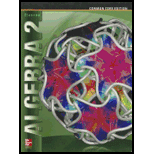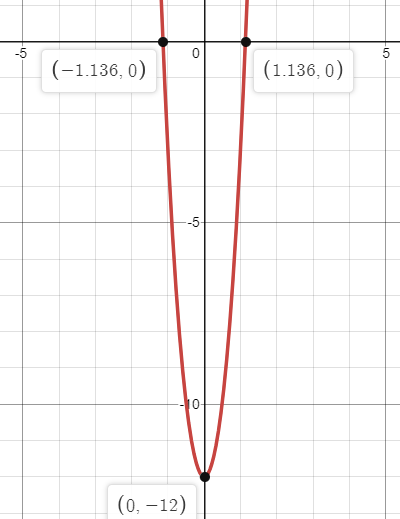
Concept explainers
(a)
To sketch: The graph of the function by making the table containing its value.
(a)
Answer to Problem 21PPS
The graph of the function is curve and it’s shown in graph above in red curve.
Explanation of Solution
Given:
Concept used:
The graph of the function
The graph can be defined by the graph of
The graph of the function is special case of the graph of an equation.
Calculation:
Table of values and graph.
Using different value of
The graph of the function

Hence, the graph of the function is curve and it’s shown in graph above in red curve.
(b)
To find: The consecutive integer value of x between the zeroes is located.
(b)
Answer to Problem 21PPS
The zeroes of the function lied in between
Explanation of Solution
Given:
Concept used:
The zeroes of the function resembled the function equates to zero.
The zero normally lies in between negative number and positive number.
Therefore, the consecutive number will negative approaches zero and positive approaches to zero except
Calculation:
Table of values and graph.
Using different value of
The points in the graph so collected will form a graph for the given equation.
The changes in sign from the result indicates that there are zeroes in between
Since, the sign of the function changes from negative to positive.
Hence the zeroes of the function lied in between
(c)
To find: The Abscissa of the relative
(c)
Answer to Problem 21PPS
There has no relative maxima and that of relative minima lied near
Explanation of Solution
Given:
Concept used:
Relative maxima:
Which is greater point than the points directly beside it at both sides.
Whereas,
Relative minimum:
Any point which is lesser than the points directly beside it at both sides.
Calculation:
The relative maxima and minima can be calculated as:
There has no relative maxima.
The value of
Hence, there has no relative maxima.and that of relative minima lied near
Chapter 5 Solutions
Glencoe Algebra 2 Student Edition C2014
Additional Math Textbook Solutions
Calculus: Early Transcendentals (2nd Edition)
A Problem Solving Approach To Mathematics For Elementary School Teachers (13th Edition)
Thinking Mathematically (6th Edition)
Intro Stats, Books a la Carte Edition (5th Edition)
Introductory Statistics
Basic Business Statistics, Student Value Edition
- Solve questions by Course Name (Ordinary Differential Equations II 2)arrow_forwardplease Solve questions by Course Name( Ordinary Differential Equations II 2)arrow_forwardInThe Northern Lights are bright flashes of colored light between 50 and 200 miles above Earth. Suppose a flash occurs 150 miles above Earth. What is the measure of arc BD, the portion of Earth from which the flash is visible? (Earth’s radius is approximately 4000 miles.)arrow_forward
- e). n! (n - 1)!arrow_forwardSuppose you flip a fair two-sided coin four times and record the result. a). List the sample space of this experiment. That is, list all possible outcomes that could occur when flipping a fair two-sided coin four total times. Assume the two sides of the coin are Heads (H) and Tails (T).arrow_forwarde). n! (n - 1)!arrow_forward
- Evaluate the following expression and show your work to support your calculations. a). 6! b). 4! 3!0! 7! c). 5!2! d). 5!2! e). n! (n - 1)!arrow_forwardAmy and Samiha have a hat that contains two playing cards, one ace and one king. They are playing a game where they randomly pick a card out of the hat four times, with replacement. Amy thinks that the probability of getting exactly two aces in four picks is equal to the probability of not getting exactly two aces in four picks. Samiha disagrees. She thinks that the probability of not getting exactly two aces is greater. The sample space of possible outcomes is listed below. A represents an ace, and K represents a king. Who is correct?arrow_forwardConsider the exponential function f(x) = 12x. Complete the sentences about the key features of the graph. The domain is all real numbers. The range is y> 0. The equation of the asymptote is y = 0 The y-intercept is 1arrow_forward
 Algebra and Trigonometry (6th Edition)AlgebraISBN:9780134463216Author:Robert F. BlitzerPublisher:PEARSON
Algebra and Trigonometry (6th Edition)AlgebraISBN:9780134463216Author:Robert F. BlitzerPublisher:PEARSON Contemporary Abstract AlgebraAlgebraISBN:9781305657960Author:Joseph GallianPublisher:Cengage Learning
Contemporary Abstract AlgebraAlgebraISBN:9781305657960Author:Joseph GallianPublisher:Cengage Learning Linear Algebra: A Modern IntroductionAlgebraISBN:9781285463247Author:David PoolePublisher:Cengage Learning
Linear Algebra: A Modern IntroductionAlgebraISBN:9781285463247Author:David PoolePublisher:Cengage Learning Algebra And Trigonometry (11th Edition)AlgebraISBN:9780135163078Author:Michael SullivanPublisher:PEARSON
Algebra And Trigonometry (11th Edition)AlgebraISBN:9780135163078Author:Michael SullivanPublisher:PEARSON Introduction to Linear Algebra, Fifth EditionAlgebraISBN:9780980232776Author:Gilbert StrangPublisher:Wellesley-Cambridge Press
Introduction to Linear Algebra, Fifth EditionAlgebraISBN:9780980232776Author:Gilbert StrangPublisher:Wellesley-Cambridge Press College Algebra (Collegiate Math)AlgebraISBN:9780077836344Author:Julie Miller, Donna GerkenPublisher:McGraw-Hill Education
College Algebra (Collegiate Math)AlgebraISBN:9780077836344Author:Julie Miller, Donna GerkenPublisher:McGraw-Hill Education





